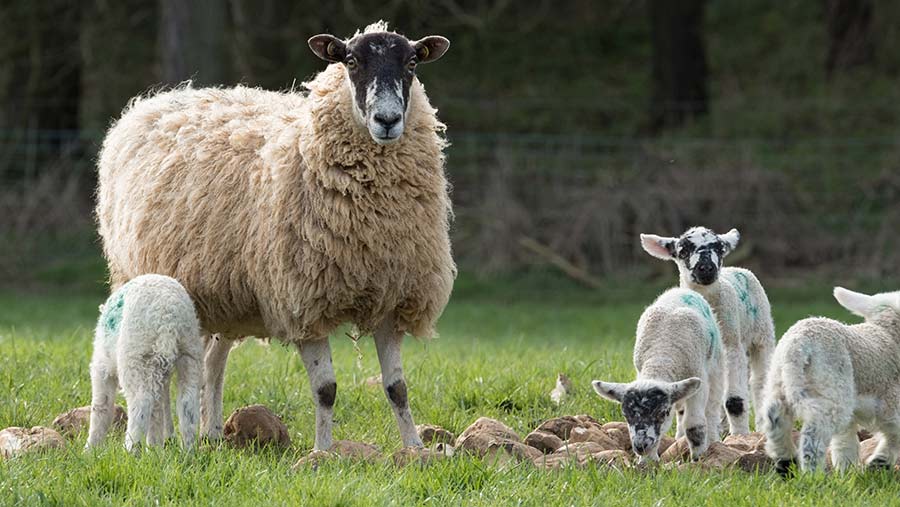Q&A: How to prevent and treat lamb coccidiosis
Coccidiosis is a costly disease, impacting lamb health and performance.
Sheep health specialist Dr Fiona Lovatt advises how to manage the disease effectively to ensure lamb performance isn’t affected this spring.

© Tim Scrivener
What is coccidiosis?
Coccidiosis is one of the most common diseases that causes production losses in UK flocks. It is generally seen in lambs from three to eight weeks old.
Coccidial oocysts, which are eaten by lambs, grow and multiply within the cells of the gut, causing wide-scale damage if left untreated.
How does it infect lambs?
Coccidial oocysts overwinter well, so oocysts from previous years will continue to remain on-farm as a source of infection.
They infect non-immune lambs via two routes:
- Oocysts remaining in the environment from previous years
- Ewes shed oocysts on to pasture or bedding when housed
Lambs ingest oocysts, and for those who have not built up natural immunity, or where the level of infection overwhelms immunity, oocysts multiply rapidly within the gut, causing permanent damage to the intestine.
Coccidial oocysts are then shed back into the environment in the lamb faeces in enormous numbers, so the cycle begins again and environmental contamination is further increased.
See also: Top 5 tips to tackle coccidiosis this lambing season
It is worth noting there are 11 species of coccidiosis that infect sheep, but only two are pathogenic. It is the pathogenic species which cause disease and significant clinical problems if the lambs are not treated.
What are the symptoms of infection?
As lambs ingest infected oocysts, there is a period before clinical signs appear. This normally lasts for about two to three weeks depending on the species of coccidiosis present.
To get on top of the issue, treating during this early phase of disease is most effective, as once extensive gut damage has occurred, it can be too late for lambs to recover.
The most recognisable symptoms that farmers need to be aware of are: weight loss, scouring, inappetence, dehydration, and in the most severe cases, lamb deaths.
Even though there may not be these obvious clinical signs, subclinical infection is also very important.
Decreased weight gain and uneven batches of lambs are key signs of subclinical infection, but can be overlooked as they can easily be confused with other factors. Both clinical and subclinical infections are a cause for concern.
Therefore it is important to determine the status on-farm as soon as possible through accurate testing – ask your vet.
How can infection be prevented?
Strategic management and planning is key to keeping on top of coccidiosis. There are a few areas in which farmers can be vigilant to help with the disease management:
- Measure lamb performance in the first eight weeks so that weight fluctuations can be noted and it is easy to identify any groups of lambs that are underperforming
- Maintain hygiene standards of lambing sheds by providing clean dry bedding
- Prevent lambs from defecating in feed and water troughs
- When lambs are at grass, be aware of heavy use areas or fields where there were issues in a previous year
- Avoid mixing age groups of lambs, and where possible avoid grazing younger lambs behind older lambs
- Ensure correct stocking density both when housed and at grass
How can it be treated?
Treatment, for example a single dose of Baycox, is best administered to all lambs in the affected group, after they have had exposure to coccidia oocysts, but before clinical signs develop.
One way to manage this is to note the dates in the diary of when different groups of lambs are most at risk, depending on their age and dates of turnout into certain fields, so treatment can be administered at the correct time to be most effective.
Testing for coccidiosis
Testing for coccidiosis is an essential part of disease diagnosis, but there is often confusion over how to correctly take a sample, the number of samples needed, and what to do once results have been given.
Between 2012-16, Scotland’s Rural University College (SRUC) tested lamb coccidia samples supplied by veterinary practices from across the UK.
The report found that 88% of samples collected over the four years contained pathogenic species of coccidiosis.
However, there were limitations in the trial, as many samples were of an insufficient number of animals, so a full-farm picture was not always known, reiterating the importance of accurate testing.
Emily Gascoigne, from XLVets Synergy Farm Health, believes it is vital accurate sampling takes place in order to get on top of coccidiosis infection.
Here, she gives her top tips for faecal egg count (FEC) sampling methods for farmers to follow this lambing season.
- Samples of muck should be taken from groups of lambs in different areas of the farm. Ideally, at least 10-15 lambs in each group should be sampled. The results will give information on the situation in different fields.
- Mark where each sample has come from, so that any “high-risk” fields can be noted for future years.
- Samples should be sent off for analysis, to determine if pathogenic coccidia are present. Many veterinary practices often offer this service either in-house, or as a part of a flock health plan, so speak to your vet if you have any concerns and wish to test for the disease.
- If results indicate high levels of coccidiosis, further tests should be conducted to identify the species present, as there are only two pathogenic species. This is done through speciation testing, which will help build a complete picture of disease on-farm.
- A species-specific diagnosis can help implement a targeted treatment strategy for the future, looking at the best time to treat, the high-risk areas on-farm, and how to protect flock productivity.
